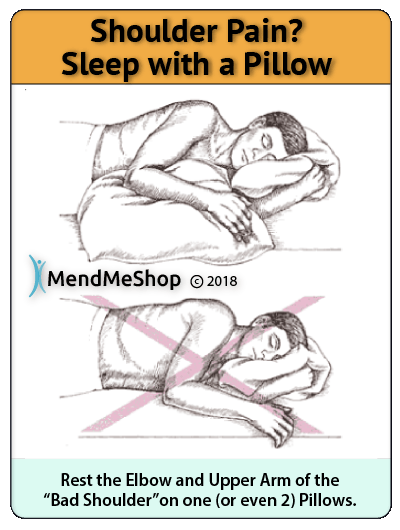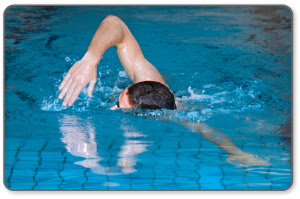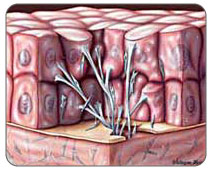The biceps (also known as the biceps brachii) is a muscle located at the front of the upper arm, the one that bumps up when you flex your arm muscles. It attaches your arm bone (humerus) to your shoulder and functions to rotate your arm from pronation to supination (twist your palm upward), and to bend your elbow and shoulder.

Biceps means 'two heads' in latin and the muscle earns its name because it joins at the shoulder in 2 places with 2 different 'heads', know as the proximal biceps tendons because they are closest to the top of the arm. The short head of the biceps tendon originates at the coracoid process of the scapula (shoulder blade). The long head of the biceps originates just above the glenoid fossa (joint cavitiy) of the scapula (shoulder blade) and runs in front of the head of the humerus along the bicipital groove, like a rope through a pulley. The transverse humeral ligament runs over top of the long head biceps tendon, holding it against the humeral head. The 2 heads of the biceps then merge and go down the length of the upper arm. It attaches at the largest part of the radius (lower arm bone) at the elbow.
Both heads of the biceps muscle are attached to the shoulder bones with their respective tendons. These tendons can become irritated and inflamed from a strain or over use of the tendon. As a result, tendonitis, tenosynovitis or a biceps tendon rupture may occur.

Biceps brachii tendon damage, inflammation, strain, or a tear typically affects the long head tendon of the biceps, as it is much more involved with the biceps group of muscles and tendons. The biceps is a commonly injured area of the body due to the large range of motion and frequent use of the shoulder joint.
Biceps tendinitis, or bicipital tendinitis (also spelled tendonitis), is a painful condition that affects the fibres of the biceps brachii tendon. Tendinitis occurs when the biceps tendon experiences small tears, is irritated, and becomes inflamed. As tendonitis develops, the tendon shealth (covering) can become thicker due to the tough scar tissue that builds up during healing. This thickening makes the tendon less flexible and prone to further injury.
Biceps tendonitis causes pain in your arm and/or shoulder and may lead to more severe problems if left untreated. The tendon and its sheath can become bound together, a condition known as adhesive tenosynovitis, which can severely restrict the range of motion within the arm and shoulder. The walls of the tendon sheath can thicken which prevents the tendon from sliding through the opening that keeps it in place, a condition known as constrictive tenosynovitis. The bicep tendon can rupture, or tear, completely which may require surgery.
Biceps tenosynovitis is a common tendon injury that typically affects older athletes. The synovial sheath (outer covering) of the biceps brachii tendon becomes inflamed and swollen. This limits the biceps tendon's ability to slide through the sheath smoothly and can cause scar tissue to build up between the tendon and its sheath restricting movement even more.
The outer tendon sheath is often initially injured due to swelling of the underlying tendon. This stretches the sheath and can cause microtears which then often bring in scar tissue which may attach to the underlying tendon, causing pain when movement occurs.
If you have biceps brachii tendonitis or tenosynovitis you may experience:

With tenosynovitis you may also experience:
With a biceps tendon rupture:
Due to the biceps muscle's connection to the shoulder joint, other problems that may occur in conjunction with biceps tendonitis include injuries such as shoulder impingement, shoulder instability, tears in the glenoid labrum that can lead to frozen shoulder, arthritis, and rotator cuff tendon tears.
In the majority of cases, wear and tear of the biceps tendon causes damage. This wear and tear is often due to overuse of the shoulder during many overhead activities that we perform in our daily lives, hobbies, and sports. With overuse, tendons can weaken with microtears that cause irritation, eventually leading to inflammation (tendinitis). When tendonitis develops over a long period of time from overuse, it is referred to as chronic tendinitis.

Biceps tendinitis often occurs with other shoulder conditions or injuries, usually with damage to the biceps tendons. A fall on an outstretched hand or a direct blow to the shoulder can cause acute tendonitis (tendinitis that comes on quickly) if the biceps tendon is damaged. If left untreated, both types of tendinitis may develop into tenosynovitis or a complete tear (rupture).
Specific causes of biceps tendonitis, tenosynovitis, and tears in the biceps tendon include:
If you have a biceps tendinitis, resting your arm is highly recommended. Avoid activities that cause pain or may have caused the inflammation and begin using a Cold Compress or Ice Pack as soon as possible.

The trick to healing your biceps tendinitis and getting your arm and shoulder back in the best possible condition you can is getting it to heal with minimal scar tissue. Due to scar tissue build up on the tendon and the amount of abnormally formed collagen, it can takes months to soften the scar tissue and improve the tissue of the tendon. By treating yourself at home with a Shoulder TShellz Wrap® everyday, minimize scar tissue growth and promote blood flow to heal your supraspinatus and other tendons fast and more completely. Even with optimum healing, there is always less elasticity in previously injured biceps tendons. However, if you heal your tendinitis properly and treat scar tissue build up, your chance of re-injury or chronic shoulder conditions later on is much lower than average.
To decrease inflammation and relieve the pain of a rotator cuff tear doctor's recommend cold compression. For an acute tear, cold compression within the first 48 - 72 hours and after re-injury is important to limit the amount of damage done to your tissue. Cold compression will relieve pain and swelling as needed and will reduce, or even eliminate, the need for NSAIDs.
Once the inflammation of your rotator cuff tear has been reduced, nourishing and strengthening the tendon tissue and surrounding area is recommended. Using Circulation Boost will speed your recovery and heal your rotator cuff more completely preparing it for strengthening exercises. Talk to your doctor or physical therapist to find out which exercises are appropriate for your situation.
After severe inflammation and swelling is reduced you can really start to work on increasing blood flow to your biceps through the use of a shoulder TShellz Wrap®. The TShellz Wrap® increases the amount of blood that flows naturally to tissue in the area to nourish the area and help maximize the ability of the body to work on healing tissue.
>Tendons and tendon sheaths naturally receive little blood supply and when you stop moving your shoulder because it hurts the blood flow is reduced even further, limiting your body's natural ability to heal itself.
By treating the biceps tendons with Circulatory Boost you can increase your body's blood supply to the area and boost the healing rate of your tenosynovitis.
A Shoulder TShellz Wrap® is the tool you need to treat biceps tendons in the shoulder. Through a process we call Circulation Boost, soft tissue in the shoulder (biceps tendons - long head and short head) are safely and gently stimulated. Your body responds with a rapid increase in blood flow to the area, increasing the supply of oxygen and nutrients to the injured tendons to promote healing. Our Shoulder TShellz Wrap® provides effective, non-invasive, non-addictive pain relief and healing with no side effects.
Enhanced blood flow from a TShellz Wrap® treatment whisks away dead tissue and toxins that have built up from your damaged tendons. When you stop moving your arm and shoulder due to shoulder pain, your muscles and other tissue can become weaker and dead tissue and toxins in the area can cause further tissue deterioration - this can lead to atrophy. By clearing the area of toxins and increasing the amount of oxygen and nutrients to your muscle and other tissue, the risk of atrophy (muscle weakness and/or deterioration) is greatly reduced. Keeping your upper arm, shoulder and rotator cuff tissue as healthy as possible throughout the healing process will allow you to improve shoulder strength again once your pain has gone and your tear has healed.
Not only does the incorporation of conservative treatments (such as the use of a Cold Compress or Ice Pack and the Shoulder TShellz Wrap®) aid in your home recovery process, but it helps to prevent long term complications. Pain, lack of mobility, tendinosis, or a complete tendon rupture are some of the more common long term complications that can occur when rotator cuff tendinitis, tendon tears, and other injuries go untreated. By treating your rotator cuff with these treatments, you can keep your joint limber and reduce the risk/frequency of re-injury - helping reducing the risk of chronic problems in the future.
During the healing process, scar tissue will build at the location of the tear. In addition, scar tissue will bind muscles, ligaments and other tissue together in the injury area. This inflexible scar tissue limits the movement of these connective tissues that were once elastic making movements painful and essentially reducing your shoulders' range of motion over time. As a result, movement of the entire joint is limited making it difficult to lift your arm or to reach for objects. If left untreated, the shoulder may 'freeze' (a condition called frozen shoulder or adhesive capsulitis) altogether making movement impossible. At the very least, scar tissue leaves your shoulder joint weaker, leaving your shoulder and rotator cuff at greater risk of further injury - this is why we urge people to incorporate the Shoulder TShellz Wrap® into their treatments! It is really an essential tool for rehabilitation and prevention of chronic (long term) injury and joint atrophy.
Remember: We recommend that you consult your doctor and/or physiotherapist before using any of our outstanding products, to make sure they're right for you and your condition.
During your recovery, you may have to modify and/or eliminate any activities that cause pain or discomfort in your biceps area until your pain and inflammation settle, and you gain more mobility and strength in your shoulder. The more diligent you are with your treatment and rehabilitation, the faster you will see successful results!
Click HERE to Go To Our Online Store We take all major credit cards and Paypal.
If you have questions, call our office at 1-866-237-9608 (toll free continental US).
We are currently offering FREE SHIPPING and a 60 day trial period on all our Wraps.
Product specialists are available 9:00 am to 5:00 pm Eastern Standard Time Monday to Friday.
If any question or concern arises, call us or simply send us an email at any time (we check our emails constantly all throughout the day and night.. even on holidays!). We will respond as soon as possible.
Learn more about Shoulder Surgery and Post-Surgery Recovery
Learn more about about how the Circulatory Boost TShellz Wrap® helps with the healing process.
Learn more about which is better for your rotator/shoulder injury - ice or heat
During your recovery, you will probably have to modify and/or eliminate any activities that cause pain or discomfort at the location of your soft tissue injury until the pain and inflammation settle. The more diligent you are with your treatment and rehabilitation, the faster you will see successful results!
Please be aware that this information is neither intended nor implied to be a substitute for professional medical advice. CALL YOUR HEALTHCARE PROVIDER IMMEDIATELY IF YOU THINK YOU MAY HAVE A MEDICAL EMERGENCY. Always seek the advice of your physician or other qualified health provider before using any of our outstanding products to make sure they're right for you and your condition or if you have any questions regarding a medical condition. Always see your doctor for a proper diagnosis as there are often many injuries and conditions (some very serious) that could be the cause of your pain.
© 2025 In.Genu Design Group, Inc. Contact Us